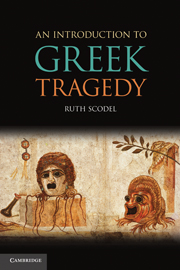4 - Historical and Intellectual Background
Published online by Cambridge University Press: 05 June 2012
Summary
Whether or not tragedy first became an established part of the festival under the democracy, the Three and their rivals knew it as an institution of the democracy, and it was the cultural product by which imperial Athens most proudly presented itself to the Greek world and to itself. It was profoundly a product of the Greek polis, the city-state. A polis was a town and its countryside that formed a political unit, and whatever the form of government, a polis was formed of citizens who had membership in it, and it had its own laws. Tragedies usually assume the polis as setting, even though the polis did not exist in the legendary past. Often the concerns of the polis are a significant background: in Libation Bearers, for example, Orestes' assassination of Aegisthus and Clytemnestra frees the polis from illegitimate and tyrannical rule (973). Not infrequently, its institutions and practices are imported into the heroic world: in Aeschylus's Suppliants, the king of Argos insists on consulting the people before he agrees to protect the Danaids, because this could lead to war and the whole polis must take responsibility for the decision (398–401).
The crucial events that define the world of Attic tragedy are the revolution of 508–507 BCE that established the constitution of Cleisthenes; the battle of Marathon in 490 BCE; the Greek-Persian War of 480–479 BCE and the subsequent formation of the Delian League; the reforms of Ephialtes c.
- Type
- Chapter
- Information
- An Introduction to Greek Tragedy , pp. 56 - 71Publisher: Cambridge University PressPrint publication year: 2010



